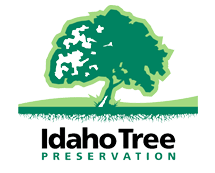Common Tree Problems
There are many potentially serious afflictions which can jeopardize the health and even the lives of our trees. This page briefly discusses the most common problems in our specific region. For a definitive diagnosis and treatment options, call to schedule an evaluation.
- Aphids: These are soft bodied plant feeding insects that can cause leaf and stem contortion in extreme cases. If you have an extreme infestation, several treatment options are available including reintroducing natural predators.
- Borers: Tree boring insects are common here in Boise and the surrounding area and can be difficult to deal with. Knowing the insect is paramount to successful treatments. Not all borers are beetles, some are clear-wing moths and these must be dealt with differently because not all common products or treatments are effective on this insect pest. Look for holes, frass (sawdust) or pitch masses on pines as signs of borer infestations.
- Sun Scald: This is a problem affecting certain species; Maples are particularly susceptible with lack of water aggravating the issue. Symptoms may include; browning and die-back of leaves on the South and West sides of the tree and die-back of leaves at the exterior of the canopy.
- Fungal: Various fungal pathogens may feed on the tree causing leaf death, twig and branch death and tree and root death and decline. Symptoms may include canopy decline with decline beginning at the interior of the canopy moving outward. You may also see spots on the leaves. Fungal pathogens are most active in cooler and wet weather. Treatment options are available.
- Girdling Roots: This can be a terminal condition in mature trees but is preventable at the time of planting and in the early years. Girdling roots are a very common occurrence and inspection at time of planting and in the first few years can completely eradicate this problem. We now offer root collar excavation and pruning of girdling roots (where possible) using the Super Sonic Air Knife, this tool allows us to clear the soil away with out damage to the tree and correct this problem. Symptoms can appear as yellowing of foliage, stunted growth, tip die back and general decline. Girdling roots can also make trees susceptible to whole tree failure due to a “pinched” trunk.
- Malpruning: Any pruning done to trees is permanent. It is very difficult to correct malpruning and it can and will cause problems including decay and the possibility of failure years down the road. Many people believe their trees are too tall and have the height reduced in an effort to make the tree safer. In fact, most height reduction pruning eventually leads to branch decay and causes the tree to become a hazard. Topping is an archaic pruning technique and is not acceptable anymore. Topping cuts will make your tree a hazard! It is imperative to the success of your tree that it be pruned correctly from the beginning.
- Drought Stress: Symptoms will include early fall color, leaf browning, tree decline, increased susceptibility to insect and disease and possible tree failure (death). Trees should be deep watered from Spring to Fall.
- Nutrient Deficiency: Many trees are not suited to our native soil and become deficient in iron, manganese or other macro and micro nutrients. Adding the nutrient may not have a positive effect on the tree because the PH of the soil is not allowing the tree to absorb the supplement. Changing the PH of your soil can be a challenge, but it is possible. Some symptoms of nutrient deficiency can include partial or complete yellowing of leaves, stunted growth, poor flower or fruit production and general decline. Call for a Consult/Evaluation meeting and we will help you identify the real issue.
- Soil pH: Often what may be called chlorosis or iron deficiency is actually related to our high soil pH. Above certain levels (commonly true here in the Treasure Valley) certain elements in the soil are bound to the soil particles. By reducing the soil pH we can often allow uptake of these elements and improve the health of the tree. Some trees which suffer from this issue are Maple (Acer) and Birch (Betula).
- Soil Compaction: This is a common problem but one which gets very little attention. Soils can be compacted during construction, from foot traffic, and by weather, water, and time. In the root zone of trees, we can’t use things such as tillers, as this would destroy the trees roots! With our Super Sonic Air Knife, we can provide decompaction of soil in a number of ways (depending on the site considerations) and recreate a positive rooting zone, thereby improving the tree’s own ability to uptake water and nutrients.
Are you experiencing any of these tree problems? Call today to schedule an evaluation!
